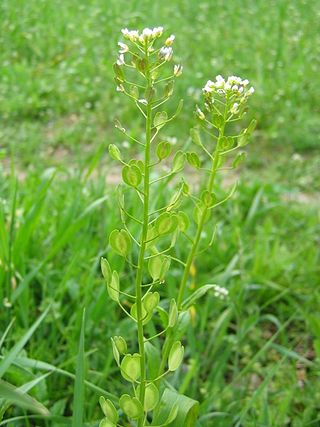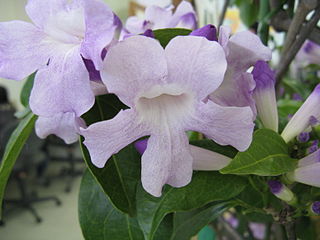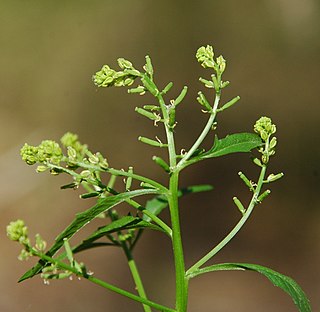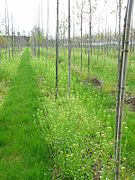Stinkweed is a common name for several noxiously scented plants, and may refer to:

Thlaspi, or pennycress, is a genus of herbs of temperate regions of the Eurasian continent. They occur in Central and South Europe, South-West Asia and two species are endemic to China. The Thlaspi has been proven to be a hyperaccumulator of heavy metals such as zinc and cadmium and therefore may be used in phytoremediation initiatives.

Thlaspi arvense, known by the common name field pennycress, is a flowering plant in the cabbage family Brassicaceae. It is native to Eurasia, and is a common weed throughout much of North America and its home.

Banksia alliacea is a species of shrub that is endemic to southwestern Western Australia. It grows to 2 m high and wide, with shaving brush-shaped inflorescences that smell of onions.

Turritis glabra, commonly known as tower rockcress or tower mustard, is a tall, slim, grey-green plant with small creamy flowers at the top of the stem. It usually grows on poor chalky or sandy soils, in open situations. It is native to Europe, Asia, and North Africa, and it is widespread in North America where it is also probably native. It can be found in many other parts of the world as an introduced species.

Peltaria is a genus of flowering plants in the family Brassicaceae. Their distribution ranges from Southeast Europe, Near East to Central Asia. They prefer rocky slopes.

Peltaria alliacea, or garlic cress, is a perennial flowering plant in the family Brassicaceae. It is endemic to Albania, Austria, Hungary, Romania and former Yugoslavia. The plant grows up to 60 cm (24 in) and has white flowers from May to July. The plant is glabrous (hairless) with simple, entire leaves. The leaves are ovate, sessile and amplexicaule. When crushed they smell of garlic, hence the common name. The 3–4 mm (0.12–0.16 in) long white petals are shortly clawed. The orbicular, very flat silicula or seed, is pendent and has a size of about 6 by 6 mm. Its chromosome number is 2n=14.

Lepidium densiflorum is a species of flowering plant in the mustard family known by the common names common pepperweed, prairie peppergrass, elongate peppergrass, hairy-fruited peppergrass, and large-fruited peppergrass.
A metallophyte is a plant that can tolerate high levels of heavy metals such as lead. Such plants range between "obligate metallophytes", and "facultative metallophytes" which can tolerate such conditions but are not confined to them.
Ihsan Ali Al-Shehbaz is an American botanist who works as adjunct professor at University of Missouri-St. Louis and Senior Curator at Missouri Botanical Garden. Al-Shehbaz's primary area of interest is Brassicaceae and The Durango Herald called him "a world expert on taxonomy of the family". A 2008 publication of the United States Fish and Wildlife Service called him "the world's authority on species in the genus Lesquerella". The author abbreviation "Al-Shehbaz" is attached to the numerous botanical taxa he has identified.

Thlaspi californicum is a rare species of flowering plant in the family Brassicaceae known by the common name Kneeland Prairie penny-cress. It is endemic to California, where it is known from only one stretch of grassland in Humboldt County. It is threatened by development. It is a federally listed endangered species of the United States.

Mansoa alliacea, or garlic vine, is a species of tropical liana in the family Bignoniaceae. It is native to Northern South America, and has spread to Central America and Brazil. Among the mestizos of the Amazon rainforest it is known as ajo sacha, a Spanish-Quechua name that means "forest garlic" or "wild garlic".
Nasturtium floridanum, common names Florida yellowcress and Florida watercress, is an aquatic plant species endemic to Florida, though widely distributed within that state. It is found in wet places at elevations less than 50 m.

Noccaea montana, the alpine pennycress, is a flowering plant in the family Brassicaceae. It is found in the Western United States. It has a basal rosette out of which grows "one or several short, unbranched stems that have small, arrow-shaped leaves and end in dense racemes of tiny white flowers."

Lepidium coronopus,, is a species of flowering plant in the mustard family which is native to parts of Africa, western Asia and Europe, growing in shingle banks, wasteland or cultivated fields.
Mycorrhizal amelioration of heavy metals or pollutants is a process by which mycorrhizal fungi in a mutualistic relationship with plants can sequester toxic compounds from the environment, as a form of bioremediation.

Eutrema is a genus of flowering plants of the family Brassicaceae, native to the Holarctic. Its best known member is wasabi, Eutrema japonicum. The name comes from the Greek εὐ- (eu-) 'well' et τρῆμα (trêma) 'hole', because of a hole in the septum of the fruit.

Rorippa sessiliflora, commonly known as stalkless yellowcress, is a species of flowering plant in the family Brassicaceae.
Mummenhoffia is a genus of flowering plants belonging to the family Brassicaceae.
Cardamine dissecta is a species of flowering plant in the mustard family Brassicaceae.














